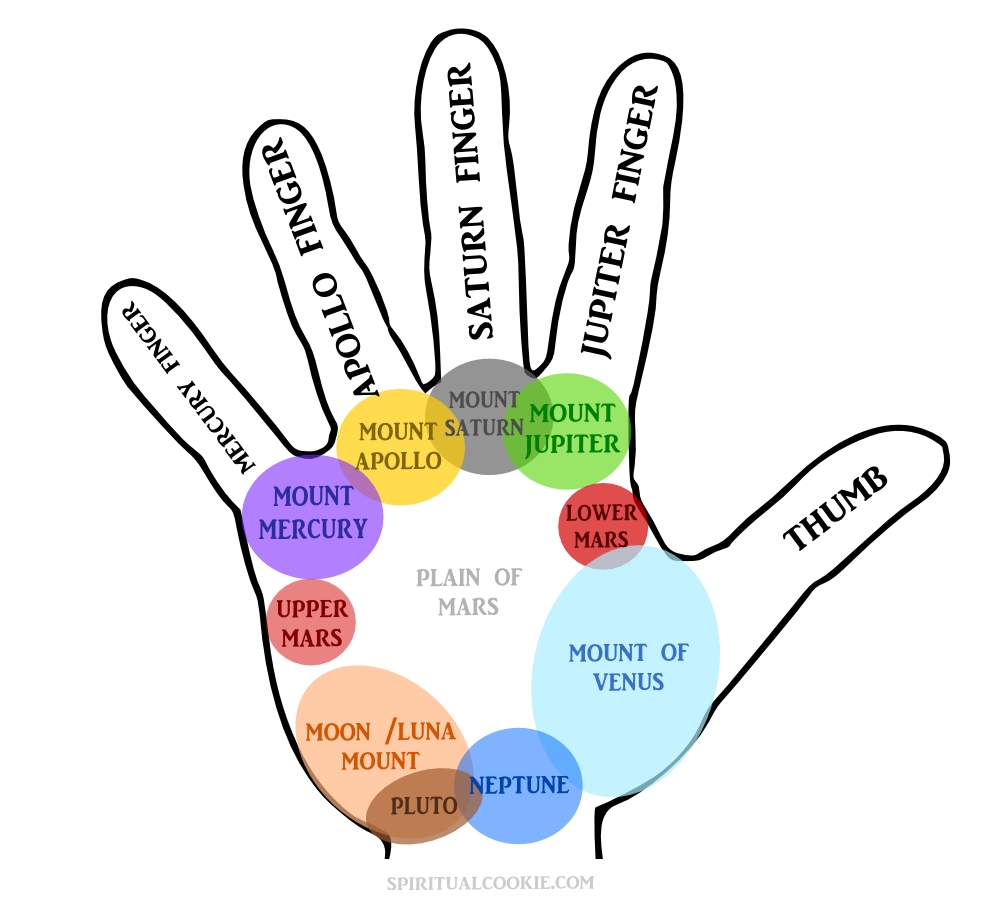If you look at your hand, palm-side up, you’ll notice you have some areas of skin that are more cushy, cushioned and fleshy than others. For example some of the “cushy” areas that are easiest to spot are those that are found under the fingers. If you look, you can see little raised circular-shaped mounds there. These areas of the palm are called the palm mounts.
Here’s a “Palmistry Mount Map” diagram showing you the mounts of the palm:

Observant readers will notice upon examining the diagram that the four mounts that are found underneath the fingers are named after the finger under which they are located, and you will later see that their meaning is also linked to the finger which they are found beneath.
Although most hand mounts are on the palm of the hand, there is also one on the dorsal surface of hand (ie on the back of the hand), called the Mars Mount (or “The Mouse”). We’ll get to that one in more detail later.
On the hand, the mounts may be slightly less obviously visible than they appear in the diagram and their location and size can differ slightly more person to person, but the diagram is a good guideline.
Ok, so we now know what palm mounts are, and where they are on the hand, but what can we tell about a person by looking at the mounts of the hand?
-
Reading Palm Mounts through examining their Prominence
Some palmists believe that the more prominent a mount appears on the hand, the more dominant its traits are in the person. A prominent mount may be one that’s particularly fleshy and raised. Sometimes a palm mount may show its prominence by appearing as a little bulge when you look at the silhouette of the hand from the front, back or side.
It can be tricky at first to recognise what’s a “normal bulge” and what’s an “unusually prominent bulge” that carries more significance. I recommend looking at as many hand as you can to get a good feel for differentiating the usual from the unusual.
To get you into the feel of things, here are a few examples of prominent mounts:
(I’ve linked the text to the relevant photos which I found online. If you click on the text below, the relevant photo should pop up.)
- Prominent moon & pluto mount
- Prominent Moon Mount
- Prominent Mount of Jupiter
- Prominent Venus Mount example 1 and example 2
Since many signs on the hand are not set in stone, I think the prominence of the hand mounts may be something that can change over time as we develop and change.
-
Reading Palm Mounts through examining lines and markings found within the Mount’s zone
Another way to use the Mounts in palmistry is to check which detailed line markings are found in the area of the palm where the mount lies. When you learn about markings and what each marking means, you’ll be able to apply the meaning of a mark to the mount area to come up with a more meaningful interpretation for each line or mark that’s observed.
-
Learning more about the specific palm mounts
You can read about what each mount represents in palmistry in the articles below:
Mounts of Mars:
(This article covers: Lower Mars, Upper Mars, The Plain of Mars and “The Mouse” Mars Mount on back of hand)
- – -
Coming soon…
Finger Mounts
- Mount of Jupiter
- Mount of Saturn
- Mount of Apollo
- Mount of Mercury
Pluto
Neptune
Click Here to go back to the Palmistry contents page
- – -
Related Products
On Amazon.co.uk
